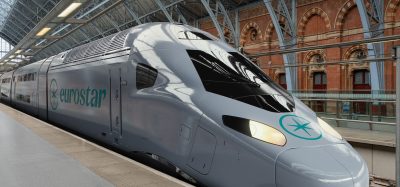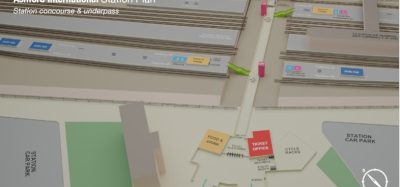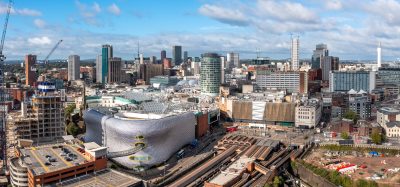Celebrating 28 years of Channel Tunnel services with 15 facts
Posted: 30 May 2022 | Elliot Robinson (Editorial Assistant - Global Railway Review) | No comments yet
To celebrate the recent 28th anniversary of the Channel Tunnel, Global Railway Review’s Elliot Robinson looks at the tunnel infrastructure in more detail, the inner workings of the services, and highlights 15 of the tunnels’ most interesting facts.
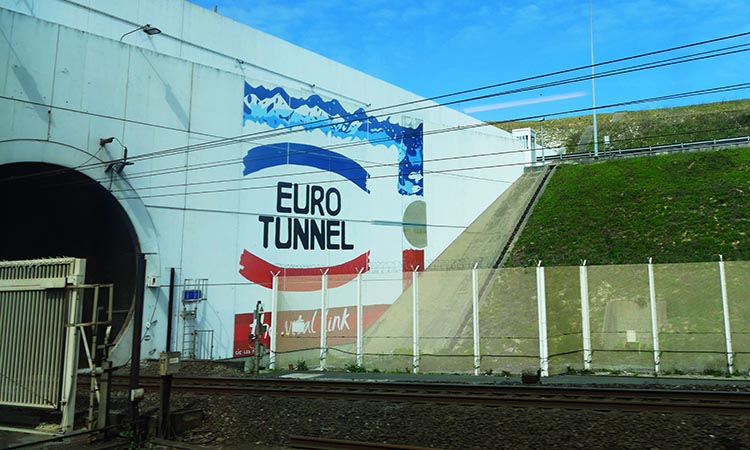

The Channel Tunnel has been a mainstay in cross-Channel transport for over 28 years. Since its formal opening by Queen Elizabeth II and President Mitterrand in May 1994, the undersea tunnel linking southern England and northern France has offered passenger vehicles (using Eurotunnel Le Shuttle services), trucks (using Eurotunnel Le Shuttle Freight services), Eurostar passengers and rail freight trains, fast travel across the Channel. From start to finish, the journey through the tunnel between Folkestone and Calais is approximately 35 minutes.
The Channel Tunnel is comprised of three tunnels: two rail tunnels, used for freight and passenger trains, and a service tunnel.
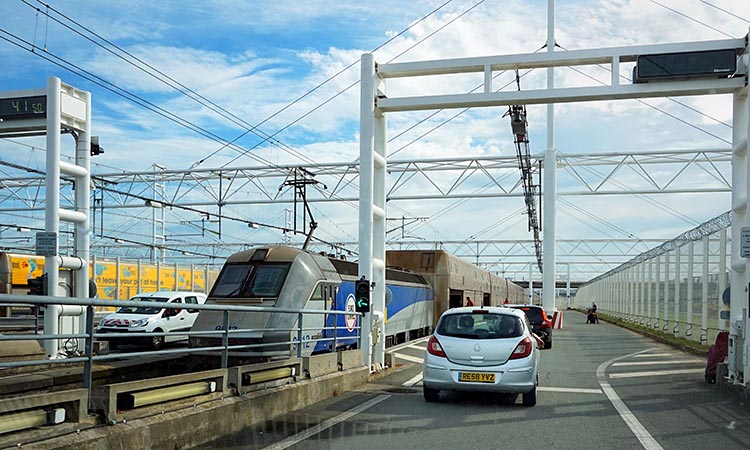

More than 80 million vehicles have boarded Le Shuttle since it opened in 1994.
The freight and passenger tunnels are 7.6m in diameter each and include single-tracks, overhead power lines (catenary), and two walkways (one for maintenance use and the other for use in an emergency evacuation). The two walkways also help keep the shuttle upright and in a straight line of travel in the event of a derailment. To ensure flexible operations, there are two crossover sections to enable trains to pass from one rail tunnel to the other; this is especially useful during periods of maintenance. Eurotunnel Shuttles, Eurostar and freight trains run on these tracks. Eurotunnel Shuttles primarily use the south tunnel when travelling from France to the UK, and the north tunnel when travelling from the UK to France.
These rail tunnels are connected by cross passages every 375 metres to give access to a main service tunnel. The service tunnel itself is 4.8m in diameter and lies 15m away from each rail tunnel. The service tunnel allows for maintenance and emergency rescue teams to access the rail tunnels in the case of an incident. The service tunnel also serves as access to the ventilation of the entire infrastructure. As a result of this, it is kept in a state of air overpressure and remains safe from fumes in case of a fire in one of the railway tunnels.
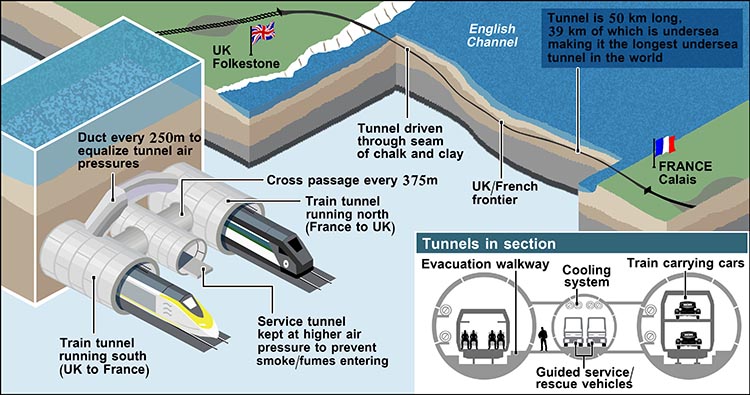

Two types of service vehicles are used in the service tunnel: unique wire guided STTS vehicles (service tunnel transport system), which feature two driving cabins at each end and a central module dedicated to either emergency services or maintenance, and electric and diesel-powered cars for maintenance purposes. Service vehicles must drive on the left when travelling in the service tunnel, and in case of incidents, rescue and emergency service teams can reach the scene of an incident in minimum time.
In each rail tunnel, the track has two continuously welded rails laid on precast concrete sleeper blocks embedded in the concrete track bed. Cooling pipes, fire mains, signalling equipment and cables are all fixed to the sides of the tunnels. The Channel Tunnel has more than 36,000 state-of-the-art systems installed across the three tunnels. For example, there are many different fire-protection systems used, including the four ‘safe’ stations in the rail tunnels, with detection systems installed at various points along the tunnels.
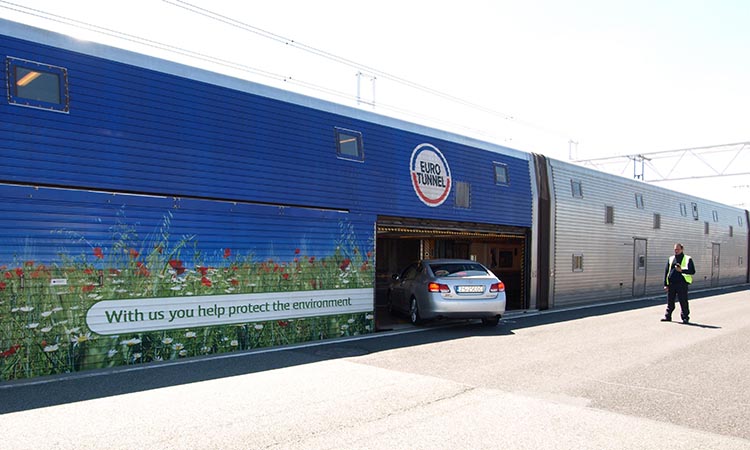

8,500 passenger vehicles were transported on Le Shuttle on 19 February 2022.
The overhead catenary infrastructure of the tunnels supplies traction power to the rolling stock. The catenary is divided into sections, so that maintenance work can be carried out in stages. Similarly, there are substations on each side of the Channel Tunnel that supply the electrical power for the tunnels, drainage pumps, lighting, and the trains. If there is any power loss from one side, the entire system can be supplied from the other side.
The entire Channel Tunnel transport system is controlled from Rail Control Centres (RCCs). There are two centres, one at each terminal, with each taking turns to take over control of the system. This system is split into two parts – the Rail Traffic Management (RTM), which controls the rail traffic system, and the Engineering Management System (EMS), which controls the fixed equipment including the ventilation, lighting, and power of the catenary.
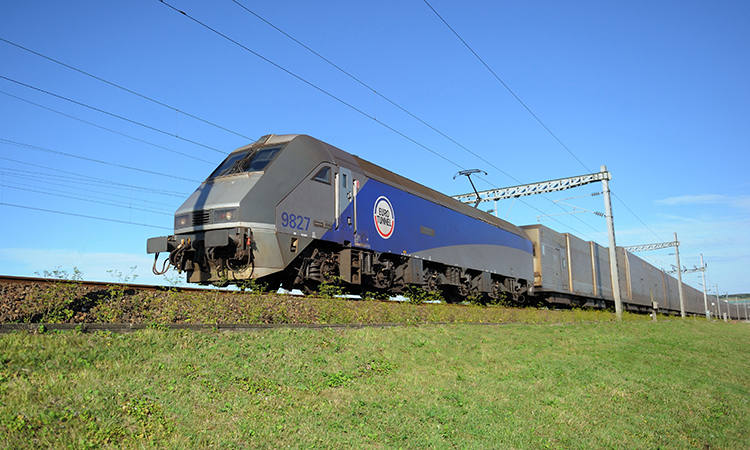

Travelling with Eurotunnel emits 73 times less CO2 than travelling by ferry.
Although it was formally opened 28 years ago, the construction of the project began back in 1988 based on initial construction proposals from the mid-1970s. However, the earliest proposals for a Channel Tunnel structure can be traced all the way back to the early 19th century. With such a long history, Global Railway Review wanted to do something special to commemorate the anniversary of the tunnel’s formal opening. Below are 15 of the most interesting facts about this legendary tunnel:
- The Channel Tunnel is the longest undersea tunnel in the world at 38km long
- 9 million cubic metres of chalk was excavated from the tunnel during construction, and this was used to enlarge the British Isles by 30 hectares to create Samphire Hoe Country Park which is situated two miles west of Dover in Kent
- There are three tunnels: two running tunnels to carry Eurotunnel freight and passenger vehicle trains and Eurostar services, and a smaller service tunnel in the middle
- The first ever passenger on Le Shuttle was HRH Queen Elizabeth II on 6 May 1994
- Since it opened, the equivalent of six times the population of the UK has crossed through the Channel Tunnel
- More than 80 million vehicles have boarded Le Shuttle since it opened (cars, trucks, motorcycles, coaches, campervans and more)
- Around one million e-commerce express delivery parcels travel via Eurotunnel each day
- A Eurotunnel passenger shuttle train is almost 800m-long, the same as seven football pitches
- If all nine Eurotunnel passenger shuttles were parked end-to-end, they would stretch for over four miles
- 26 per cent of goods traded between the UK and continental Europe go through the Channel Tunnel
- The Channel Tunnel is one of the Seven Wonders of the Modern World, alongside the Empire State Building and the Panama Canal
- The completion of the Channel Tunnel meant that the island of Great Britain could be connected with the European mainland by land for the first time since the Ice Age, about 8,000 years ago
- Eurotunnel Le Shuttle has transported over 62 million cars since its inception in 1994
- The busiest day of 2022 so far was on 19 February; 8,500 passenger vehicles were transported on Le Shuttle
- Travelling with Eurotunnel emits 73 times less CO2 than travelling by ferry.
(facts supplied by Kitten & Shark).
Stay Connected with Global Railway Review — Subscribe for Free!
Get exclusive access to the latest rail industry insights from Global Railway Review — all tailored to your interests.
✅ Expert-Led Webinars – Gain insights from global industry leaders
✅ Weekly News & Reports – Rail project updates, thought leadership, and exclusive interviews
✅ Partner Innovations – Discover cutting-edge rail technologies
✅ Print/Digital Magazine – Enjoy two in-depth issues per year, packed with expert content
Choose the updates that matter most to you. Sign up now to stay informed, inspired, and connected — all for free!
Thank you for being part of our community. Let’s keep shaping the future of rail together!
Related topics
Cargo, Freight & Heavy-Haul, High-Speed Rail, Infrastructure Developments, Operational Performance, Passenger Experience/Satisfaction, Route Development, Sustainability/Decarbonisation, Track/Infrastructure Maintenance & Engineering




